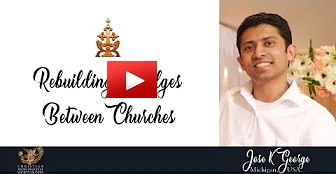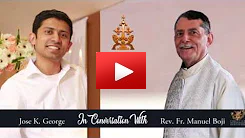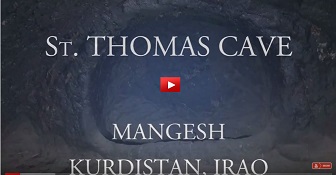Interviews and Performances - Video List
Aramaic Project - III
No. 10 to 1
Goto No. - 4 | 3 | 2 | 1| Aramaic Project Number | Description | Duration | Date of Recording | Place of Recording | Video |
III-5 AP 211/AP3-05 |
Ranna Abro sings Qaddisa Alaha. The melody in the Chaldean Catholic Church The melody of Qaddisa Alaha from the Chaldean Catholic Church in Michigan, USA, in the voice of Ranna Abro.The video helps us to make comparative studies of the melody and the pronunciation of the text. Making the sign of the Cross is part of the minor doxology (1:05). The final cadence includes the addition of a neume (a group of notes sung to a single syllable) in an otherwise syllabic setting (single note to a syllable) of the text. Obviously, Ranna sings "Qaddisa, instead of Qandisa) We are grateful to Jose George Mappilaparampil for making the record happen. Keywords: Ranna Abro, Trisagion, Qaddisa Alaha, Chaldean Catholic Church |
3:19 | 27 April 2020. | Residence of Ranna Abro, Michigan, USA. |  |
III-4 AP 210/AP3-04 |
Ranna Abro sings Laku Mara. Melody of Chaldean Catholic Church of the East. The melody of the Resurrection Hymn in the Chaldean Catholic Church of the East, Michigan, USA.
See also (Aramaic Project-III.3). Special thanks to Ranna Abro for granting permission to post this video on our Channel Ranna Abro, a member of the Chaldean Catholic Church of the East, in Michigan, USA, was kind enough to share this video of her singing the Resurrection hymn as per our request. Ranna was one of the three participants in the interview that Jose K. George conducted earlier (see Aramaic Project-III.3). We have an opportunity here to get acquainted with the melodies of the same chants that are part of the East Syriac liturgy that the Chaldean Catholic and Syro Malabar Churches share. Eventually, with more samples, we intend to start a Musical Ecumenism series. Ranna made the recording in the comfort space of her own home. We see Ranna making the sign of the Cross during the minor doxology (Glory be to the Father.....), even though the singing takes place in an informal setting outside the liturgy. Albeit the differences in the vocalization of the Syriac text, the melodies are similar. It is possible that the melodies in the two churches have a common ancestor, and they assumed different characteristics in the varied linguistic and cultural settings of the respective countries. This and other similar videos that are on the editing table may serve as resources for an new era of comparative Christian musicology. We are grateful to Jose K. George Mappilapparampil for mediating the process of adding this new dimension to the Aramaic Project. Joseph J. Palackal, CMI |
3:45 | 27 April 2020. | Residence of Ranna Abro, Michigan, USA. |  |
III-3 AP 209/AP3-03 |
JOSE K. GEORGE Mappilaparampil: Rebuilding Bridges between Churches Jose K. George in conversation with Chris Salem, Evette Shahra, and Ranna Abro. Sterling Heights, Michigan Note: The geographical positioning of Jose K. George in the vicinity of the Chaldean Catholic Church in Michigan and his friendship with socially active youthful members of the church led to this exciting and informative interview. The interview brings back memories of the long-lost bond between the Chaldean Catholic Church and the Syro Malabar Church. The connection between these two ancient churches is not part of the conversation among the present generations in Iraq, Michigan, or India. For that reason, we are grateful to Jose K. George and his wife, Diana Paul, for their initiative to create this documentary. The interview opens up topics for conversations among the youths of both churches. The three youngsters, who participate in this interview, are socially active members of the Chaldean Catholic community in Michigan. More importantly, Chris Salem, Evette Shahra, and Ranna Abro consider their Syriac heritage, both cultural and liturgical, to be a precious part of their lives. They are office-bearers in the Shlama Foundation (shlamfoundation.org) that works to save an endangered cultural heritage of humanity. They motivate expatriate Chaldeans in Michigan are as well as in other parts of the USA to reach out to the suffering churches in Iraq: Chaldean Catholic Church, Assyrian Church of the East, and Syriac Catholic Church; those churches are under attack from enemies from all sides who are determined to destroy their unique religious and cultural treasures. The interview includes singing of hymns from the Chaldean liturgy, which Syro Malabar Church inherited. For example, the Anthem of the Mysteries (Pagre damsiha) and the Resurrection hymn (Laku Mara) are very familiar to the Aramaic Project audience. We have documented several recordings of these hymns (see Encyclopedia of Syriac Chants ). In this video, Ranna Abro volunteered to sing those hymns. Ranna’s rendering is useful for musicologists and linguists to make a comparative study of the pronunciations, melodic variations, and performance practices between the Chaldean Catholic and Syro Malabar traditions. This is a rich yet largely neglected area of research. Chris Salem shares a poignant story behind the Resurrection Hymn, Laku Mara, that adds another layer of meaning to that chant. It also tells us how liturgical song texts affect ordinary lives under extraordinary circumstances. Beyond liturgical songs, Chaldeans also use Aramaic for lullabies and nursery rhymes. Jose George creates a context in the conversation for Evette to sing one example of a nursery rhyme. Evette is also working on developing computer software to teach the Syriac language. Overall, there is so much material in this video that may prompt further conversations that can be inspirational to the audience of our Aramaic Project. Earlier, Jose K. George had a fruitful conversation with Fr. Manuel Boji, the Vicar of the Chaldean Catholic parish in Michigan (see Aramaic Project-III-2). The Syro Malabar Christians are not alone. They can look for a partnership with the Chaldean Catholic Church and even think of collaborations on common projects that would be beneficial for both parties. Christian Musicological Society is immensely grateful to Jose K. George and Diana Paul for this joint venture of advancing understanding between seemingly disparate communities across the globe. They organized the interview at their home, bypassing several inconveniences. Their little son was a silent witness to the conversations, albeit asking periodically for attention from his parents. We have to wait and see what impact it created on his mental computer. References: See notes on Aramaic Project-III.2 , Aramaic Project-178 Joseph J. Palackal, CMINew York 8 May 2020 |
28:55 | Holy Martyr's Chaldean Catholic Church, Sterling Heights, Michigan, USA |
 |
|
III-2 AP 208/AP3-02 |
JOSE K. GEORGE: EXPLORING ELEMENTS FROM A SHARED LITURGICAL TRADITION Jose K. George in conversation with Fr. Manuel Boji, Vicar, Holy Martyrs Chaldean Catholic Church, Sterling Heights, Michigan, USA. The focus of this informed conversation is on the shared liturgical traditions of the Syro Malabar Church and the Chaldean Catholic Church. Saturday, 7 December 2019 Note: In this video, Jose K. George, a member of the Syro Malabar Church in Michigan, USA, is expanding the geographical domain of Part III of the Aramaic Project. We started Part III with a video that our Research Assistant, Joseph Thekkedath Puthenkudy, sent from Iraq. Jose K. George is interviewing Fr. Manuel Boji, who serves the Chaldean Catholic community in Michigan, which consists of mostly immigrants from the troubled Iraqi regions. This community fervently hold on to their ancient tradition. Syro Malabar Church and Chaldean Catholic Church use the same anaphora of Addai and Mari. The focus of this conversation is on the familiar yet different elements in this shared tradition between two sister churches. Of particular interest is the conversation on Puqdankon. According to Fr. Boji, the Patriarch and the Synod took the initiative to introduce it to the Chaldean Catholic liturgy, but the response from the priests was lukewarm. This part of the conversation also validates Fr. Varghese Pathikulangara’s view that Puqdankon is of Malabar origin (Pathikulangara, “Qurbana,” 1998, p.153). Interestingly, Fr. Boji gives a different explanation, based on the Chaldean tradition and the private conversations among the clergy. It gives us the impression that the Syro Malabar Church should be proud of this tradition and uphold it in its original sense. Puqdankon, with its multiple layers of meanings, defies translation into other languages. The interview leads us to more questions on the melodic repertory, especially of the liturgy of the Hours. A comparative study of the melodies of the same chant text in the Chaldean Catholic Church and the Syro Malabar Church may be beneficial. We are grateful to Jose K. George and Diana Paul for taking the time to create this segment for the Aramaic Project. We hope we can get more resources from the Chaldean Catholic Church in Michigan through the mediation of Jose K. George. Joseph J. Palackal, CMICMI New York 27 April 2020 Keywords: Jose George, Fr. Manuel Boji, Chaldean Catholic Church, Syro Malabar Church |
31:21 | 7 December, 2019 Holy Martyrs Chaldean Catholic Church, Sterling Heights, Michigan, USA |
 |
|
|
AP 207/AP3-01 |
St. Thomas the Apostle at Mangesh, Kurdistan (autonomous region), Iraq
Note: With this video, we inaugurate the third phase of the Aramaic Project. In this phase, we plan to post as much information as possible from the Chaldean Catholic Church of Babylon. Historically and liturgically, the Syro Malabar Church and the Chaldean Catholic Church are intimately connected. That connection, however, is seldom a part of the daily discourse among the members of the two churches. Both churches claim the St. Thomas tradition. The content of this video reinforces that awareness of the shared apostolic faith. Both churches use the same anaphora of Addai and Mari. Most of the chant texts are the same, but the melodies are different. We plan to collect as many melodies as possible for future researchers for comparative studies. Our introduction to the current status of the Chaldean Catholic Church is the result of a short-lived sojourn of Joseph Thekkedath Puthenkudy, in Mosul, Iraq. Joseph used his time in Iraq to get as much information as possible. But for Joseph, communication on the current musical status of these churches would not have been available to the Aramaic Project audience because the emotional distance between the two churches is longer than the geographical distance. We hope that Ethnomusicology departments in Western universities will make use of these materials for research. Joseph J. Palackal, CMINew York 1 March 2020 |
5:26 |
Kurdistan (autonomous region), Iraq 3 November, 2019
|
 |


